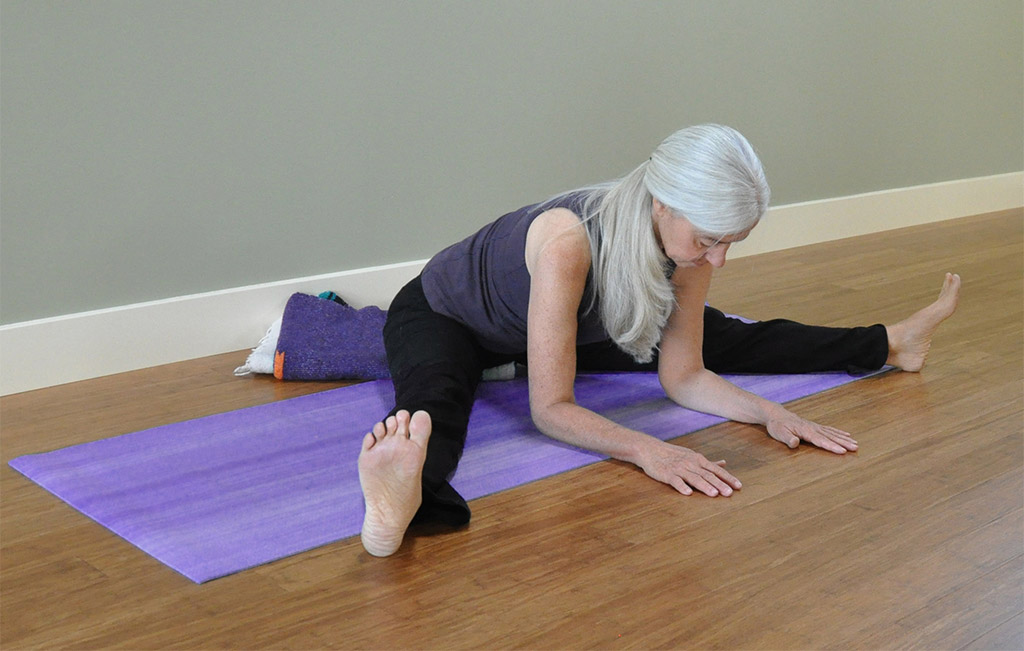This entry was posted on Jan 18, 2024 by Charlotte Bell.

Some years ago, I led some yoga students through a rather lengthy series of leg-stretching asanas based on Supta Padanghustasana (Supine Big Toe Pose). At that time, I had always ended the series with a one-legged version of Yoganidrasana (ankles behind the head). Of course, most people in my classes feel pretty flexible if their foot ends up within a few inches of their faces. And honestly, that’s really quite flexible compared to the average person on the street. Some might even think that’s an indication of being an advanced yogi.
The orientation and depth of many people’s hip sockets will never allow an Instagram star expression of the pose. I’m one of the few people whose hip joints are amenable to Yoganidrasana, and to poses such as Padmasana (Lotus Pose). I don’t take particular pride in this; it’s not something I earned through hard work. It’s simply a genetic variation I inherited from my gymnast father.
Yoganidrasana and the SI Joint
The instructions for moving into Yoganidrasana can be confusing to students, probably because the pose has nothing in common with everyday movement. When I demonstrated Yoganidrasana, it was for clarity. It was, in fact, helpful to demonstrate the version that most people can accomplish. This involves bending one knee toward the chest, placing the ankle in the bend of the opposite elbow and drawing the leg in toward the chest. As I offered the option—somewhat jokingly—of slipping the ankle behind the head, it occurred to me to do what I’ve often done: Demonstrate.
For a week prior to this class, I’d been struggling with sacroiliac (SI) pain and sciatica. I attribute this to my genetically loose joints, along with years of practicing alignment instructions that I later found to be inappropriate. In addition, youthful enthusiasm inspired me to try every “advanced” pose I could force myself into back in the 1980s. As a result, my SI joint has become fragile and unstable.
Trashing Your SI Joint Does Not Make Anyone an Advanced Yogi
My SI joint is the proverbial canary in the coal mine for me. On one hand, it’s quite useful; it gives me immediate feedback when my alignment is ever-so-slightly unhealthy. I’ve learned volumes about healthy SI-joint alignment from living with this extremely sensitive and communicative joint. On the other hand, my SI joint misaligns easily and turns excruciatingly painful at the slightest provocation.
So this time, when I had the option to demonstrate Yoganidrasana, I chose the prudent path and opted out. By opting out, I saved myself SI trouble. But more important, I walked my talk. I would never encourage a student to push past SI and sciatica pain. The only motivation I can think of for sliding my foot behind my head would be to prove that I could do it, to show my students what an “advanced yogi” I am.
Why Class Levels Don’t Work for Yoga
I’ve long advocated for a different definition of the “advanced” yogi. Defined class levels (Level 1, 2, 3 and 4) seem artificial, limiting and inaccurate to me. Some people come to yoga with bodies that will do almost every pose on the first day. For example, some people can push up into Urdva Dhanurasana (Upward Bow) with straight arms (the requirement for entering some Level 3 classes) with no restrictions. On the other hand, a yogi with 30 years’ experience may have been born with more stable joints. More stable joints will often not allow arms to be straight in Upward Bow. This person would not be able to attend an “advanced” class. These parameters do not seem useful to me.
What Is an Advanced Yogi?
For me, an advanced yogi is one who has a two-way communication with his/her body—speaking and listening. An advanced yogi has the experience to know when he/she is too exhausted, injured or fragile to practice a particular pose. An experienced yogi knows that the degree to which you can stretch, the number of Chaturangas (yoga push-ups) you can do, the length of time you can stay in Headstand, or having straight arms in Urdva Dhanurasana does not matter in the grand scheme. An advanced yogi’s ego is in check enough to know that what your body can or can’t do is not a measure of your commitment to yoga. The mature yoga practitioner knows that just because you can do a particular pose doesn’t mean that you should.
Donna Farhi teaches that advanced yogis may choose to opt out of doing the most “advanced” variations of poses, rather than push themselves to the point of injury. Advanced yogis are the people who know that yoga is not about performance, but about freedom from the need to perform. I have to agree. My decision to opt out of Yoganidrasana tastes far more of freedom than wedging my ankle behind my head ever could.
About Charlotte Bell
Charlotte Bell discovered yoga in 1982 and began teaching in 1986. Charlotte is the author of Mindful Yoga, Mindful Life: A Guide for Everyday Practice and Yoga for Meditators, both published by Rodmell Press. Her third book is titled Hip-Healthy Asana: The Yoga Practitioner’s Guide to Protecting the Hips and Avoiding SI Joint Pain (Shambhala Publications). She writes a monthly column for CATALYST Magazine and serves as editor for Yoga U Online. Charlotte is a founding board member for GreenTREE Yoga, a non-profit that brings yoga to underserved populations. A lifelong musician, Charlotte plays oboe and English horn in the Salt Lake Symphony and folk sextet Red Rock Rondo, whose DVD won two Emmy awards in 2010.

